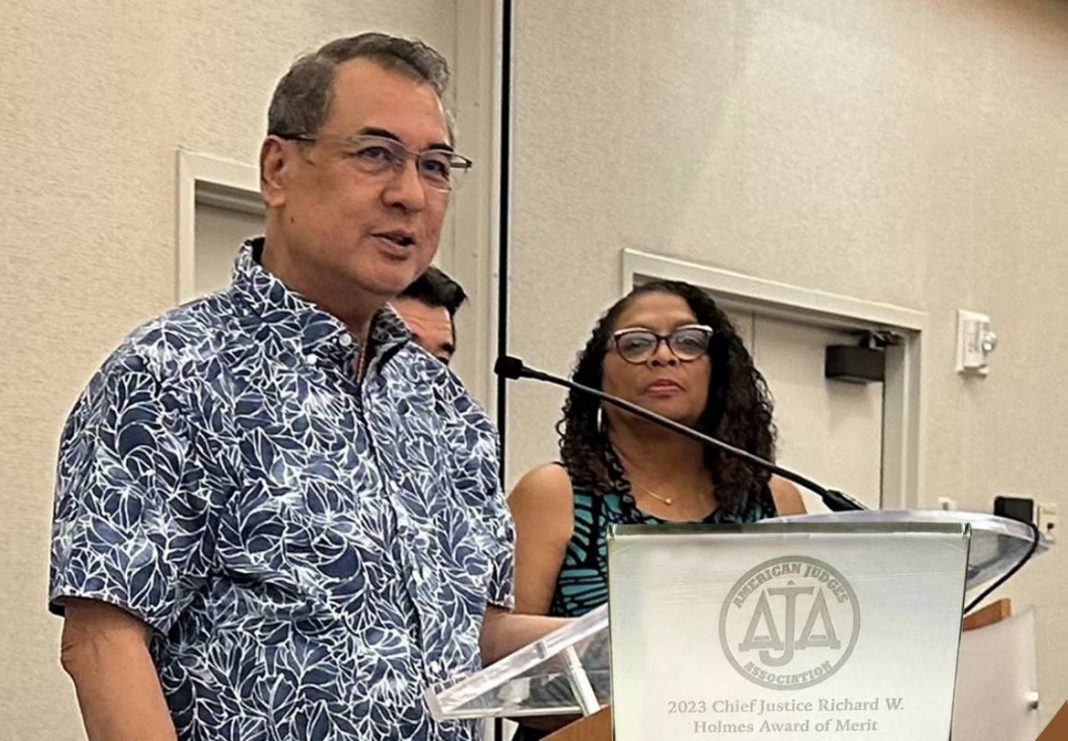Chief justice Alexander Gesmundo highlighted the initiatives of the Supreme Court (SC) in utilizing technological advancements at the 2023 American Judges Association 62nd Annual Conference held in Honolulu, Hawaii on Wednesday, Sept. 13.
In one of the sessions titled “Tech Talk with the Chiefs” where he was invited as one of the featured speakers alongside chief justice Robert Torres of the Supreme Court of Guam, the chief justices had an informative conversation about technology and its challenges and opportunities in their respective judiciaries.
The magistrates shared their insights and experiences on modern technology in the courts and provided a thought-provoking discussion about the future of technology in the judicial system.
Gesmundo brought to the fore the SC’s Strategic Plan for Judicial Innovations 2022-2027 (SPJI), the judiciary’s blueprint for digital transformation and the steps that the court has taken to utilize modern technology to improve court efficiency and access to justice.
Gesmundo shared the “three pillars for a successful digital transformation: 60% people, 20% process, and 20% technology.”
He emphasized that what is critical are the people’s mindset and the culture of transformation and change since people have the highest share in this formula.
“To be able to successfully transform digitally, we must build on the strategic alignment towards the initiative, develop capabilities needed to adapt to the change, build and maintain a culture that sustains the change,” he explained.
Gesmundo also identified the judiciary’s best practices adopted in its digital transformation journey.
According to him, it starts with identifying a business strategy: “This means understanding the peculiar challenges and opportunities presented to the Philippine Judiciary and charting a course that leverages the power of technology to achieve efficiency, innovation, and access.”
He emphasized that behind every successful digital transformation is a well-defined roadmap that aligns with the core mandate of the organization.
Gesmundo further shared what he identified as the very backbone of the judicial system: the court employees.
“By involving them at the outset, we empower our employees to be change drivers as we tap into their expertise, creating a collaborative environment where ideas are co-created,” he said.
The SC chief also recognized the fear of irrelevance when confronted with the prospect of digital transformation, especially due to lack of knowledge or skillset.
He thus underscored that “the Philippine Judiciary is investing in various training initiatives, workshops, and resources to equip not only our employees but also members of the Bar with the requisite tools and skillsets needed to thrive in this digital era.”
He likewise shared the latest updates on technological advancements that the SC has adopted, namely:
- Judiciary e-Payment Solution or JePS;
- Digitalized Benchbook;
- Philippine Judiciary 365;
- Philippine Judicial Academy Learning Management System;
- Human Resource Management System;
- Financial Management Information System;
- Bar Applicant Registration Information System and Tech Assistance or BARISTA;
- eFiling under the eCourt System version 2.0; and
- Artificial Intelligence (AI) for Court Operations
With the rapid pace of technological advancement, however, Gesmundo mentioned the issues that Philippine courts are currently facing such as:
- Cybercrimes;
- Handling digital evidence;
- Challenges on jurisdiction in the digital realm;
- Integration of LegalTech tools in court processes;
- Expert witnesses in cases involving complex technological concepts;
- Use of AI algorithms in determining criminal sentences, considering issues of transparency, accountability, and fairness;
- Utilization of AI tools for legal research;
- Algorithmic accountability; and
- Legality and authenticity of AI-generated content.
Gesmundo concluded his talk by emphasizing that “these challenges underscore the need of the Philippine Judiciary to remain adaptable, invest in technology infrastructure, and develop legal frameworks that align with the digital age while adhering to principles of justice, equity, and due process.”
For his part, Guam’s Torres touched on generative AI and how it can be used in the judiciary, including its benefits and potential challenges.
He discussed that generative AI may be utilized in the justice system in predicting case outcomes, better assistance to litigants, review legal documents, automate legal research, provide better training to the legal community, and assist in making judicial decisions.
The two chief justices agreed that the use of generative AI in the judiciary should be done responsibly and users should be cautious on its possible misuse, such as generating fake documents, promoting lazy lawyering, and having poorly managed AI tools.
The magistrates discussed that courts should be aware that AI programs exist and must ensure that appropriate data governance are in place to properly apply and regulate AI tools.
They also emphasized that appropriate uses of generative AI should be promoted and there must be proper feedback on the effectiveness of these programs for the judiciary.
The Philippine delegation to the Hawaii event was led by Gesmundo and associate justice Jose Midas P. Marquez. Joining them were deputy clerk of court and chief technology officer Jed Sherwin G. Uy; Antonio Caesar R. Manila, judicial staff head at Office of the Chief Justice; and second- level trial court judges.
The conference, themed “Innovative Courts for a Modern Judiciary,” commenced on Sept. 9 and concluded on Sept. 14.




